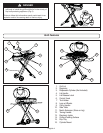Special offers from our partners!

Find Replacement BBQ Parts for 20,308 Models. Repair your BBQ today.

English-9
WARNING
r Keep the grill area clean and free from combustible
materials, gasoline and other ammable vapors, liquids,
and spare L.P. cylinders.
r To avoid the possibility of tipping over the grill, NEVER
place more than 20 pounds on the side table. A lled
4-quart aluminum pot weighs approximately 10 pounds.
r DO NOT obstruct the ow of combustion and ventilation air.
r Keep the ventilation opening(s) of the L.P. cylinder
enclosure free and clear of debris.
r A barbecue grill becomes hot during use. DO NOT touch
grates, or cooking surfaces.
r Be sure to tighten all hardware (screws, nuts, bolts, etc.)
at least once a year or before each grilling season.
Condition The Grill
r Before using the grill for the rst time, or after storage,
operate the grill 15 minutes on the high setting with the lid
closed, to burn away oil.
r Once the oil has burned away, check the burner ame per
the next step.
The Burner Flame
r Open the grill lid. The cooking grates should be in place.
r Keep your arms and face away from being directly above
the cooking area. Look through the cooking grates and
observe the burner’s ame below.
r Flames should appear similar to the good ame shown in
Fig. 34 and as follows:
r A good ame should be blue with a yellow tip.
CAUTION
DO NOT touch hot grill parts with your bare hands!
You MUST use protective gloves.
CAUTION
Be certain the disposable cylinder is disconnected when
the grill is placed in storage.
Burner Control Setting Tips
r The high ame setting is too hot for direct cooking. The
high ame setting is good for quick searing of meat, then
nish cooking on medium or low ame settings.
r Use the high ame setting with the lid closed to preheat
the grill for 5 minutes before cooking and with the lid
closed for a maximum of 5 minutes after cooking to burn
off grease drippings.
r Use a medium ame setting for direct cooking of steaks,
pork chops, chicken and hamburgers.
r Use a low ame setting for roasts.
r Thick steaks will nish with a better texture and more juice
if rst seared on high ame setting and then cooked on a
low ame setting.
Safe Grill Operation
r NEVER leave cooking food unattended. Continually
observing the food will help in maintaining an even
temperature, conserve fuel, improve the food’s avor and
lessen are-ups.
Shutting Off the Grill
Grilling Tips and Hints
General Use and Correct Burner Flames
r Some yellow tips on ames up to 1 inch in length are
acceptable as long as no carbon or soot deposits appear.
r If ames are excessively yellow and irregular, the oil
residue may not be completely burned off, or the venturi
may be clogged or may not be properly positioned over
the orices. Allow the grill to cool before repositioning the
venturi over the valve and orices.
r Grills that have been in use for a while sometimes begin to
show more yellow ame. A build-up of food deposits, fats
or cooking seasonings can cause yellowing ames. Clean
the burner to remove residue and check for clogged burner
holes or a blocked venturi. Refer to the section titled
“Cleaning the Venturi”.
r Regular use of your grill will actually help keep it operating
more smoothly.
r Each grill may heat differently. Some units will heat
somewhat more to the center and back of the grill. The
avor of grilled food will improve the more you use the grill
and as you become familiar with it.
■ Turn all burner control knobs to off. (Fig. 33)
Fig. 33
Yellow
Blue
Holes in Burner
Yellow
Blue
Good Bad
Fig. 34


















